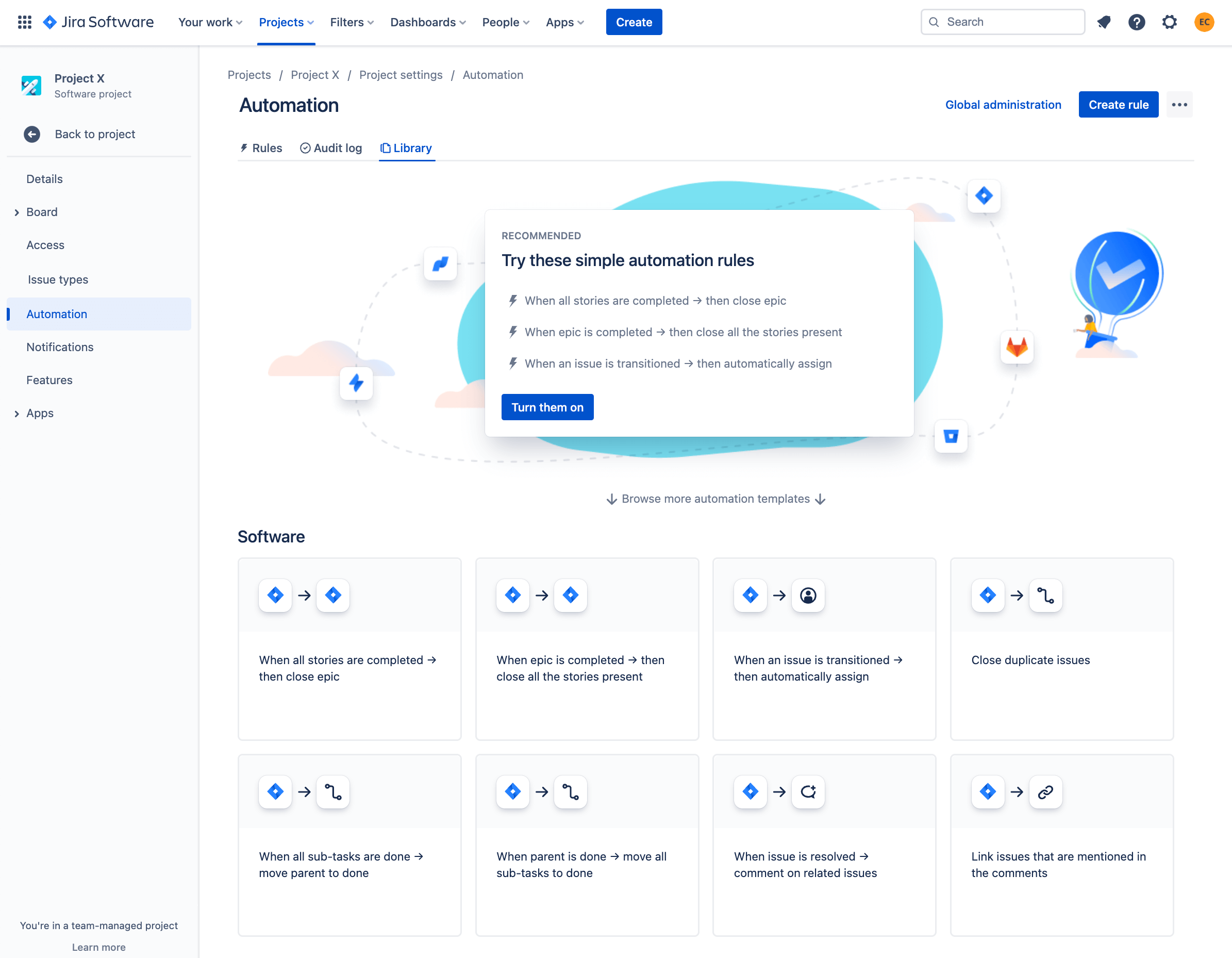Jira 자동화: 기본 사항 및 일반적인 사용 사례
Automation이란 무엇인가요?
자동화를 사용하면 팀에서 작업, 프로세스, 워크플로를 자동화하여 반복적 수동 작업을 할 필요 없이 중요한 일에 집중할 수 있습니다. 코드가 필요하지 않은 간단한 규칙 작성기를 사용하면 몇 번의 클릭만으로 가장 단순하고 반복적인 작업부터 가장 복잡한 시나리오까지 모든 것을 처리하는 자동화 규칙을 만들 수 있습니다.
자동화는 현재 Jira Cloud 및 Confluence Cloud에서 사용할 수 있습니다.
자동화 규칙의 핵심 요소는 무엇입니까?
자동화 규칙은 규칙을 시작하는 트리거, 규칙을 구체화하는 조건, 그리고 사이트에서 작업을 수행하는 동작 등의 세 가지 부분으로 이루어져 있습니다.
Triggers, conditions, and actions are the building blocks of automation. Simply combine these components to create rules that can do anything from auto-closing old work items to notifying specific teams when a release has been shipped.
시작하는 데 도움이 되는 자동화 템플릿은 제품 라이브러리에서 찾을 수 있습니다.

그리고 자동화 템플릿 라이브러리에서는 사용하고 배울 수 있는 자동화 템플릿 및 가이드를 더 많이 찾아볼 수 있습니다.
트리거란 무엇입니까?
Every rule starts with a trigger. They kick off the execution of your rules. Triggers will listen for events in Jira, such as when a work item is created or when a field value is changed. You can also trigger rules to run from third party services like Bitbucket or GitHub.
트리거는 설정하거나 예약한 조건에 따라 수동으로 실행하도록 설정할 수 있습니다.
조건이란 무엇입니까?
Conditions allow you to narrow the scope of your rule. They must be met for your rule to continue running. For example, you can set up your rule to only escalate a work item if it is high priority.
조건이 충족되지 않으면 규칙이 실행 중지되고 조건에 뒤따르는 동작이 수행되지 않습니다.
동작이란 무엇입니까?
Actions are the doers of your rule. They allow you to automate tasks and make changes within your site. They allow you to perform many tasks, such as editing a work item, sending a notification, or creating sub-tasks.
브랜치란 무엇입니까?
Work items in Jira rarely exist in isolation. They often contain sub-tasks, are stories that are part of a larger epic, or are simply linked to other work items using certain relationships. This means that when using automation, actions often need to apply, not only to the source work item that triggered the rule, but also to any work items that are related to the source work item.
Special conditions and actions are available to create powerful rules that can work across complex work item relationships. For example, checking that all sub-tasks of a parent work item are resolved.
스마트 값이란 무엇입니까?
Smart values allow you to access and manipulate a wide range of work item data within your site. They can add significant power and complexity to your rules. For example, the smart value {{now.plusDays(5)}} references the current time and adds 5 days to it, while {{issue.summary}} will print off the summary of the work item.
규칙 실행자란 무엇입니까?
The rule actor is the user who executes a rule. This user must have the relevant permissions to trigger the rule, and complete any actions that may be performed. For example, if a rule is created that will comment on a work item when executed, the rule actor must have the Add comment permission, otherwise the rule will result in an error.
사이트에서 규칙 실행자는 Automation 앱 사용자로 설정됩니다. 하지만 이제 자동화 규칙의 규칙 실행자를 변경할 수 있습니다.
규칙 상태란 무엇입니까?
자동화 규칙의 상태를 확인하여 규칙이 현재 활성화되었는지 식별할 수 있습니다. 규칙이 비활성화되어 있는 경우, 활성화되기 전까지 실행되지 않습니다. 규칙의 상태는 세부 정보 화면에서 확인할 수 있습니다.
- 사용 규칙이 현재 활성화된 상태입니다.
- 사용 안 함 규칙을 현재 사용하지 않습니다.
- 초안 규칙에 게시되지 않은 변경 사항이 있습니다.

감사 로그란 무엇입니까?
각 규칙에는 감사 로그가 있어서 규칙이 트리거된 시기, 실행의 최종 결과 및 수행된 가능성이 있는 모든 동작을 확인할 수 있습니다.
개별 규칙의 감사 로그를 프로젝트 전반 또는 전역 수준으로 확인할 수 있습니다. 감사 로그를 확인하는 것은 규칙을 디버깅하는 데 효과적입니다.
